Table of Contents
As an HR professional, you are no stranger to the traditional annual performance review process. It is:
- Time-Consuming
- Stressful
- Dreaded Experience
A report by the management research firm CEB revealed that 95% of managers expressed discontent with their companies’ performance review processes, and almost 90% of HR leaders believed that the process did not deliver accurate information.
Thankfully, technological advancements have revolutionized the way companies handle performance reviews.
Developing innovative tools and methods has resulted in a more efficient, effective, and streamlined evaluation process.
These modern methods include:
- Data-Driven Evaluations
- Continuous Feedback Systems
- Workforce ManagementTools
The new-age methods provide valuable insights into employee performance for better performance evaluation.
This blog will explore these modern methods and how they can help better transform the performance review process.
So, whether you’re an HR leader or a people manager, get ready to take your performance management game to the next level!
Let’s get started by understanding the following:
Popular Methods of performance review
The most popular performance review methods are traditional or conventional ways of evaluating an employee’s performance.
These are based on periodic evaluations conducted by a supervisor or manager and are often conducted annually or bi-annually.
The most common traditional methods of performance reviews include:
1) Annual Performance Review
This method involves conducting a formal review of an employee’s performance on an annual basis.
The review may be based on employee’s:
- Performance compared to organizational goals
- Accomplishments and achievements
- Areas of improvement
2) Rating Scales Method
The method involves evaluating an employee’s performance using a rating scale, typically on a scale of 1 to 5 or 1 to 10.
The rating scale can include criteria such as:
- Quality of work
- Daily productivity
- Communication skills
- Teamwork
The employee’s overall rating is calculated by averaging the ratings of each criterion.
3) Checklist Method
This method involves creating a checklist of criteria and evaluating the employee on each criterion. The criteria may include:
- Attendance
- Time management
- Job knowledge
- Problem-solving Skills
The employee is evaluated against each criterion and given a score on a scale of 0 to 5 or 0 to 10.
4) Narrative Evaluations
This method involves written comments by the supervisor or manager about the employee’s:
- Strengths and weaknesses
- Areas for improvement
Narrative evaluations can provide more detailed feedback than other methods and a better context for the employee’s performance.
While some organizations still use these review methods, others have moved away from them due to their challenges.
Let’s understand:
Why are these popular employee performance review methods failing employers?
Employers increasingly realize that the popular/traditional employee performance review method of simply evaluating an individual’s job performance every year is becoming outdated.
Here are a few reasons why this approach is failing employers:
1) Limited Data
The traditional performance review method relies on a one-time, often subjective evaluation of an employee’s performance.
This limited data can lead to the following:
- Inaccurate assessments
- Inability to measure long-term performance
- Limited ability to compare performance among peers
- Failure to capture real-time performance
2) Time-Consuming Process
The traditional performance review process can be a time-consuming burden on employers, especially those with large teams or many direct reports.
- It takes a considerable amount of time to collect and analyze data
- The review meetings can be lengthy and time-consuming
- Providing feedback and setting goals for the next year requires significant planning
3) Inaccuracy
The traditional performance review method can be subject to bias and inaccuracy, as evaluations are often based on the opinion of a single reviewer.
This can lead to the following:
- Unfair evaluations for employee performance
- Evaluation errors that can lead to rewarding underperforming employees or demotivating high-performing employees
- A lack of transparency in the evaluation process
4) Lack of Frequency
Traditional performance reviews are often conducted annually or bi-annually, so employers may be unable to address performance issues on time.
This can lead to the following:
- A lack of accountability for both employers and employees
- Missed opportunities for improvement
- Lack of responsiveness to changing business needs or job requirements
As we are now familiar with the traditional performance review methods and why they are failing employers, we can explore:
“Modernizing performance management: modern methods for assessing employee performance”
The traditional performance review methods have been replaced by modern, technology-driven tools and methods that provide a more comprehensive, accurate, and responsive approach to performance management.
These modern methods include:
1) Continuous Feedback
Continuous feedback refers to the practice of providing feedback on an ongoing basis throughout the year instead of once annually. It is often given through:
- Formal Conversations
- Surveys
- Online Questionnaires.
This method can provide employees with:
- Timely & frequent feedback
- Real-time updates of performance and progress
- Increased engagement with management
- Better understanding of company goals
2) Management by Objectives (MBO)
MBO is a performance management approach that involves setting
S- Specific
M- Measurable
A- Achievable
R- Relevant
T- Time-Bound Objectives For Employees.
It focuses on setting clear goals and expectations and then measuring their progress. This method provides:
- Increased accountability
- Greater alignment with company goals
- Clear direction and focus for employees
- Increased motivation and job satisfaction
3) 360-Degree Feedback:
360-degree feedback is a performance management tool that allows employers to gather performance information from multiple sources, including:
- Coworkers
- Supervisors
- Customers
This method can provide:
- More comprehensive and transparent feedback
- Insights based on multiple perspectives
- Increased objectivity in performance evaluation
4) Behaviorally anchored rating scale (BARS):
Behaviorally anchored rating scale is a modern method that combines the qualitative and quantitative aspects of performance management.
It is a performance appraisal method that identifies specific behaviors important for job success and uses them as anchors to rate employee performance.
This method can provide:
- Objectivity and fairness in evaluation
- Specific examples of job behaviors
- Clear communication of expectations
- Quantitative data on performance
As we are now familiar with the modern methods for assessing employee performance, let’s explore:
Modernizing Performance Management: Modern Methods For Assessing Employee Performance
Modern tools for evaluating employee performance have greatly evolved in recent years.
A wide range of software tools is available to help managers and HR professionals effectively evaluate their team’s performance.
Here are some common types of modern tools for evaluating employee performance:
1) Tasks & Project Management software:
These tools help employees and managers effectively organize their tasks and projects. They can help with:
- Tracking progress
- Assigning tasks
- Setting deadlines
Use of the tools makes it easier to evaluate employee performance based on completed tasks and achieved goals.
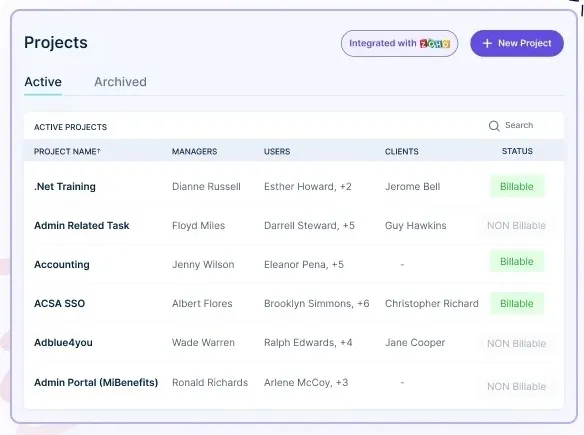
2) Time & Productivity Tracking Software:
This software allows employees and managers to track:
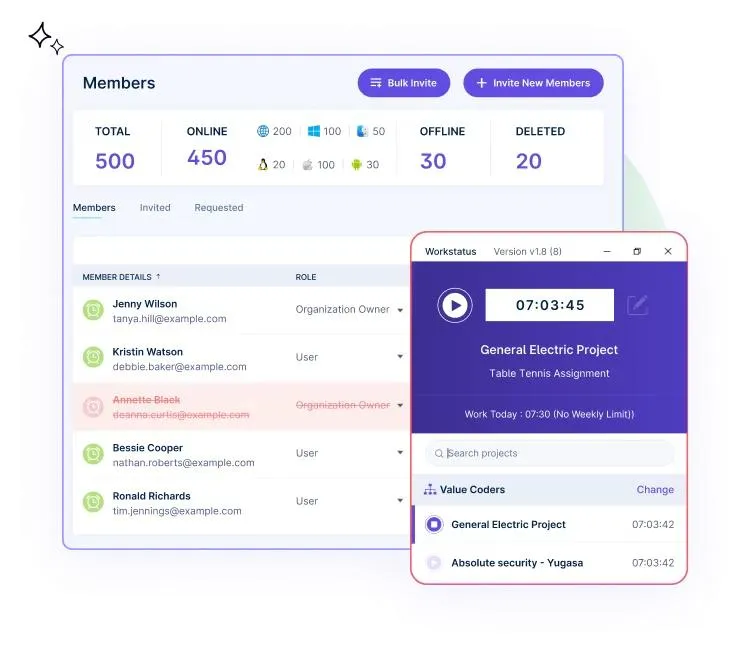
- The time spent on specific tasks or projects
- The productivity and performance of team members
- Progress of individual tasks and projects
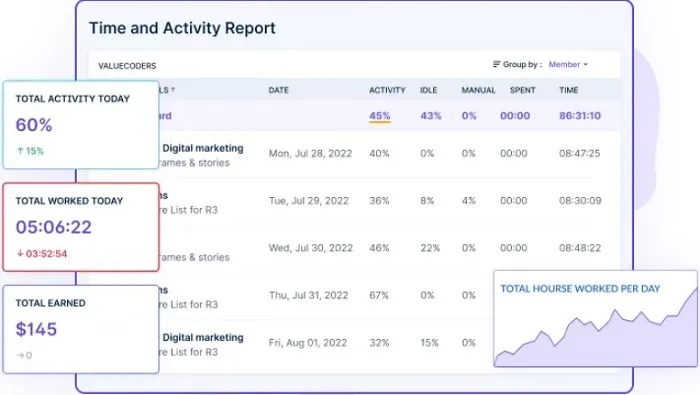
It gives a detailed breakdown of productivity levels that can be used to evaluate employee performance and identify areas for improvement.
3) Data Analytics & Reporting Tools:
These tools allow managers and HR professionals to analyze data related to employee performance, such as:
- Performance Metrics
- Attendance Records
- Timesheets
- Project And Todos
- Weekly Progress
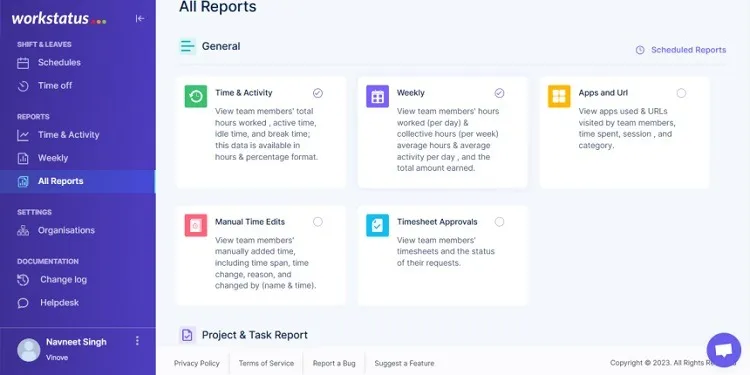
This information can be used to evaluate individual and team performance and identify patterns and trends that can help improve overall performance.
4) Performance Management Software:
These tools are designed specifically for evaluating employee performance. They typically include features such as:
- Goal-setting
- Performance tracking
- Performance review management
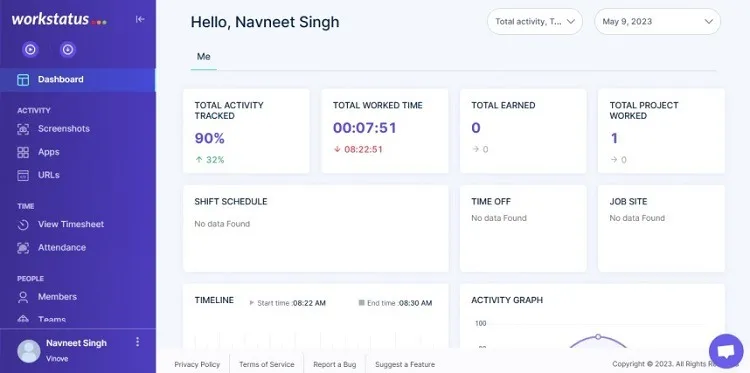
Performance management software helps ensure that employee performance evaluations are consistent, fair, and objective.
By leveraging these tools, organizations can make data-driven decisions, improve their overall performance management processes, and ensure that employees meet their goals.
However, getting all these tools to work together can be a challenge.
Bringing It All Together: Workstatus The One-Stop Platform For Performance Evaluation
Workstatus is a comprehensive platform that combines all the above tools for performance evaluation in one place.

It offers a range of features that enable managers and HR professionals to effectively manage their teams’ performance.
Here are some of the features offered by Workstatus:
1) Productivity Tracking
Workstatus provides productivity insights by tracking and analyzing employee activity levels. It can help managers understand how productive their team is by:
- Monitoring Time Spent On Tasks
- Tracking Employee Activity Levels
- Viewing The Total Project Worked
- Understanding Performance & Activity Graph
This helps HR and managers have complete visibility into team performance, which helps them evaluate their employees’ effectiveness in meeting business goals.
2) Time Tracking
Workstatus’ time tracking feature allows for accurate tracking of employee hours worked, enabling managers to evaluate employee performance and assess their productivity levels.
This feature includes:
- Automated time tracking
- AI-powered timesheets
- Idle time detection
With this information, HR and managers can make informed decisions regarding employee performance and evaluate their performance by tracking their hours worked and the tasks they complete.
3) Central Dashboard
Workstatus’ central dashboard provides up-to-date metrics to help managers and HR professionals continuously review their team’s performance.
This includes:
- Monitor time spent on tasks
- Track employee activity levels
- View the total project worked
- Understand performance and activity graph
This helps managers to automate the review process by providing all performance metrics through a single dashboard, allowing HR to evaluate employee performance quickly.
4) Real-time Reports
Workstatus’ real-time reporting feature enables managers and HR professionals to provide continuous feedback on employee performance.
With this feature, managers can get different reports, such as:
- Time & activity reports
- Weekly reports
- App & URL visited
- Timesheets approval
- Project & to-dos
- Dynamic reports
These reports can be customized to meet specific needs and can guide the employee in the area where their performance will be evaluated.
By combining all of these tools in one platform, Workstatus:
- Streamlines The Performance Evaluation Process
- Save Time And Effort For Managers And HR Professionals
- Provide Valuable Insights For Employees, And Increase Transparency Across The Team.
Next Step
In conclusion, employee performance evaluation is crucial to any organization’s success.
Organizations can evaluate their employees’ performance more effectively by using modern methods and tools, such as:
- Real-time feedback
- 360-degree evaluations
- Objective setting
- Comprehensive platforms Like Workstatus
These modern tools and techniques provide a more holistic view of employee performance by incorporating factors like:
- Performance
- Project views
- Real-time productivity insights
In a world where the traditional annual performance review is no longer effective, these modern methods and tools provide organizations with the means to evaluate employee success more accurately and efficiently.
So what are you waiting for?
Start incorporating modern performance evaluation tools like Workstatus in your organization today and reap the rewards!
Sign up for free and revolutionize the way you evaluate employee performance.
That’s all for today.
Thanks for reading!
FAQs
Q: What is the importance of performance reviews in evaluating employee success?
A: Performance reviews are an essential tool for evaluating employee success because they provide an opportunity for managers and employees to:
- Discuss performance
- Set goals
- Identify strengths and areas for improvement
- Provide feedback
Performance reviews help promote employee engagement, improve productivity, and ultimately contribute to the organization’s success.
Q: What are some best practices for conducting effective performance reviews?
A: Some best practices for conducting effective performance reviews include:
- Setting clear goals and expectations
- Providing regular feedback throughout the year
- Being objective and fair
- Using technology to streamline the process
It is also important to focus on strengths and areas for improvement and provide actionable feedback to help employees develop and grow.












